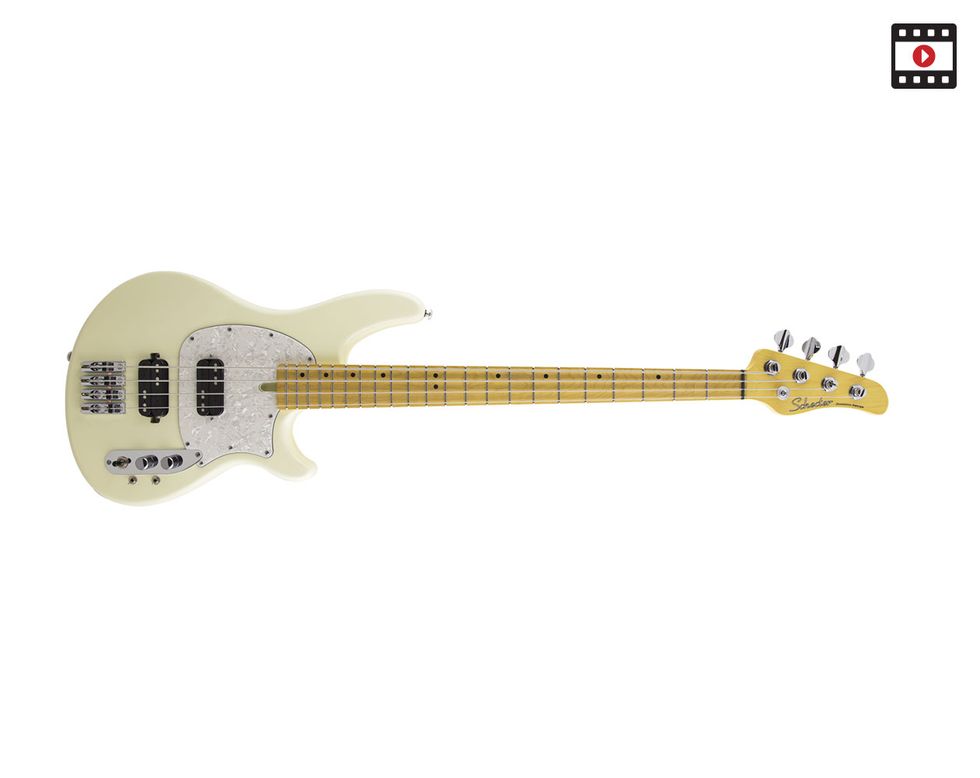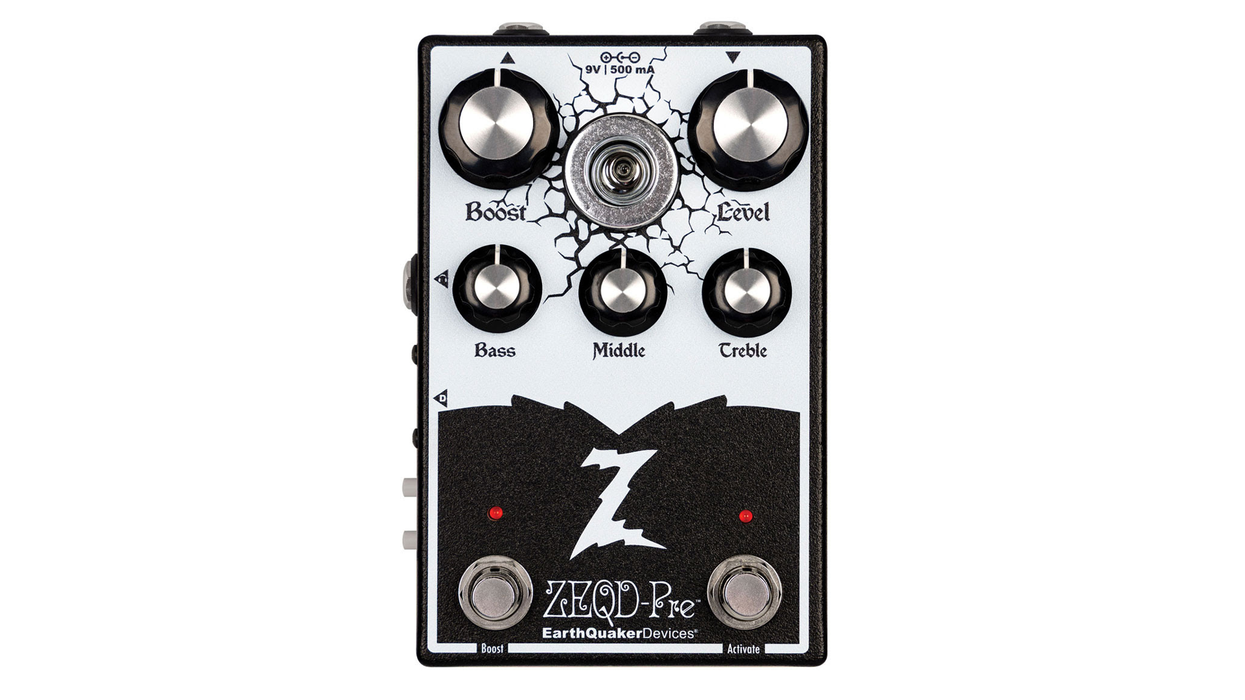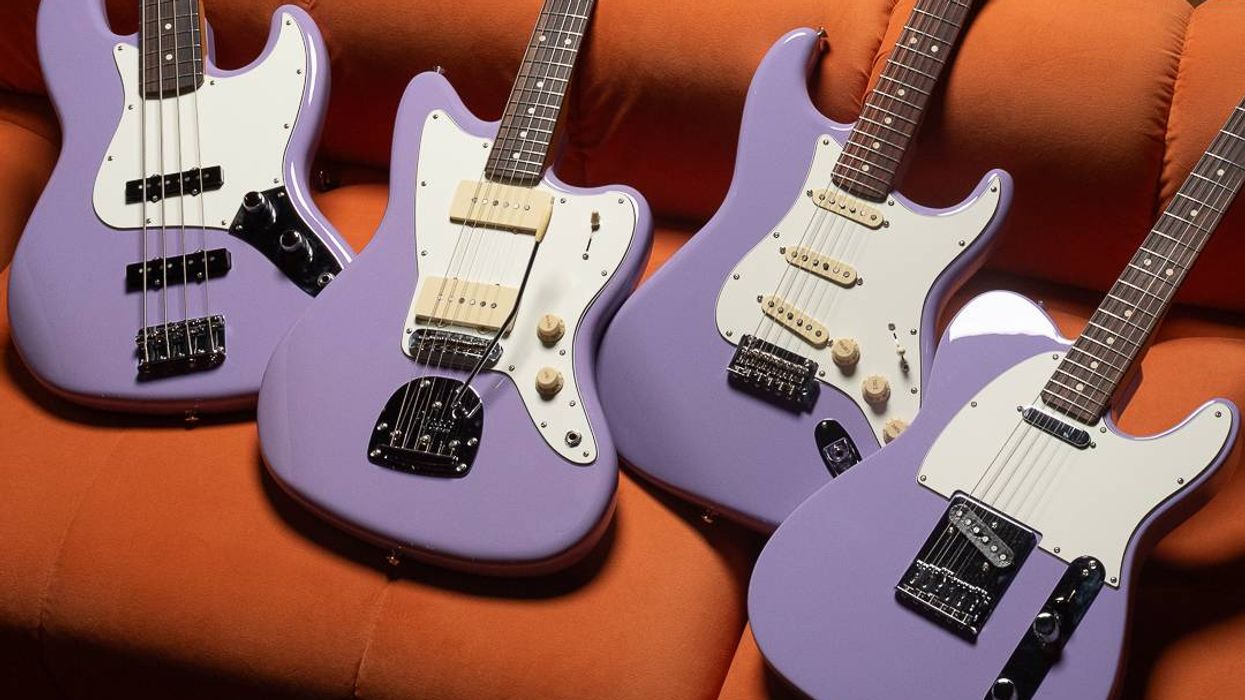
Recorded using Mesa/Boogie 400+ head, Mesa/Boogie Powerhouse 4x10 cabinet, and PreSonus AudioBox iTwo interface.
Clip 1 - Bridge pickup soloed in series humbucking mode.
Clip 2 - Neck pickup soloed in split mode.
For decades, Schecter has been pursuing the industry grail of high-quality/low-price instruments. So it should come as no surprise that the new CV-4 is a no-frills love letter to hard-rock bassists who yearn for an instrument that can cover a lot of ground, deliver the traditional qualities of passive electronics, and stay within a blue-collar budget. Across the continually widening sea of budget-conscious basses, however, it has less in common with a brand-new, here-today-gone-tomorrow model than it does with a well-loved modified P or J bass sitting in a pawnshop window.
Lay Down the Law
The CV-4 is available in ivory white, three-tone sunburst, and natural finishes. The fit and finish of our ivory white review model looked flawless and devoid of any hasty tool marks or imprecise screw-hole alignments that aren’t a surprise to see on lower-priced basses. Given that the bass doesn’t come with a gig bag, we were relieved when it arrived at our doorstep well packed. One shouldn’t expect a bass in this price range to come with a hardshell case, but an inexpensive nylon bag would have been nice with a price tag close to $600.
The CV-4 is equipped with a carbon-fiber-reinforced maple neck that’s finished with a satin sealer. I really loved the feel of its C-shaped profile, which had just enough mass to feel substantial and a slender carve that felt akin to a well-worn Precision. The neck is capped with a 22-fret maple fretboard (the natural models are outfitted with rosewood fretboards), equipped with a nice set of open-gear tuners, and attached to the body via a solid 6-screw neck joint.
The body itself felt surprisingly lightweight given its ash composition. And when I was playing—either standing or sitting—the CV-4’s curvy contours made for a supremely comfortable instrument. This is partially thanks to the position of the rear strap button, which is higher up on the body to maintain balance and tilt the neck up when in a standing position.
The strings are fed through an S-Tek bridge, which features hardened-steel saddles. For electronics, the CV-4 houses a pair of Schecter’s passive Diamond J-Buckers, a master volume, and tone. Each pickup is wired to its own 3-way switch that selects between series, parallel, or coil-split configurations. In lieu of a blend control, a 3-way toggle switch selects either pickup individually or in combination.
Bridging the Gap
My test rig for the CV-4 consisted of a Mesa/Boogie 400+ head and a matching Powerhouse 4x10 cabinet. With the bridge pickup selected and in series mode, my fingerpicked tone had a thick and responsive low end with a pleasing rubbery snap in its midrange. After dialing up a bit of grit from the Mesa’s preamp, the pickup roared with an authoritative growl. The highs were smooth and audible in contrast to the rest of the tone’s spectrum, but I had to dig into the strings with a bit more force than I was used to if I wanted to coax more presence out of them. I wasn’t overly concerned since I was using the pickup’s full humbucking mode at the time, but for someone who likes a lot of responsiveness in his or her pickups, it’s something worth pointing out.
Switching to split-coil mode, the tone expectedly grew more focused and less bottom-heavy. The pickup did a great job at detecting even the tiniest nuances of my picking hand—from my fingers sliding across the strings to coordinated muting with both hands. Moreover, there was very little background noise. So little, in fact, that I had to turn the amp’s master volume way up just to see if there was any noise at all. The parallel mode delivered a healthy mix of the split mode’s spring-like snap and the series mode’s tubby lows, coupled with a forceful twang that applied a brilliant presence to slap-and-pop playing.
Ratings
Pros:
Excellent fit and finish. Fabulously comfortable neck. Pickups are quiet in all modes.
Cons:
Pickups can be stiff and lack responsiveness. No gig bag.
Tones:
Playability:
Build/Design:
Value:
Street:
$569
Schecter CV-4
schecterguitars.com
Up to My Neck in You
To demo the neck position in series mode, I switched gears to a more moderate musical attitude and a squeaky clean amp tone. The lows grew to a corpulent size, yet didn’t overpower the clarity of the midrange as I picked through fast chromatic runs using a light touch. I could hear a strong low-mid presence, which made sense given the instrument’s intention of being a one-size-fits-all, rock-oriented bass.
In split mode, the neck position had a similar tonality and response to the bridge position. The low end was considerably narrower and tighter while giving up a little volume to allow the low-midrange to punch through. This resulted in a grinding rumble that—when combined with a little drive from the preamp—was my favorite tone from the CV-4. With liberal use of the tone knob, it had just the right blend of low-end tightness, low-mid punch, and rounded highs to cover an entire set of pissed-off hard-rock, metal, grind, and thrash tunes. If the pickup hadn’t lost much of the attack responsiveness it had before switching from series mode, my opinion of it would have been even higher.
The Verdict
Most rock bassists are after an instrument that both feels familiar and can dish out the goods in a no-nonsense fashion. The CV-4 delivers in those regards. Moreover, the series/split/parallel switching is a great addition for those who want to venture into as many tonal landscapes as possible. But unlike a number of other basses that offer the same feature, the CV-4’s switches are positioned in a way where you’d be hard-pressed to switch them accidentally. The CV-4 does have some trade-offs, such as the pickups lacking responsiveness at times and the bass not being packed with a gig bag for protection, but its authoritative and versatile tones, extremely comfortable neck, and attractive price point make this bass an option that any budget-minded rocker should consider.
Watch the Review Demo:







![Rig Rundown: AFI [2025]](https://www.premierguitar.com/media-library/youtube.jpg?id=62064741&width=1245&height=700&quality=70&coordinates=0%2C0%2C0%2C0)












 Shop Scott's Rig
Shop Scott's Rig















































